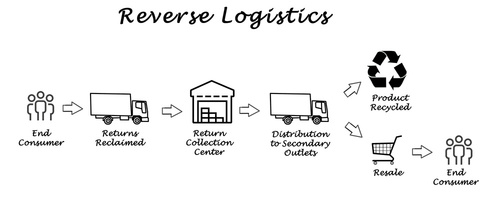A functional reverse logistics approach works perfectly when it comes to enhancing the user experience and even reducing overall inventory costs. Reverse logistics, in the truest possible sense, signifies a strategy that remains active after the point-of-sale and aims at recapturing the product value. This approach also ensures that the returned product is disposed of perfectly following the process of remanufacturing, replacement and refurbishment. Basically, reverse logistics makes the best use of excess inventory and scrap followed by efficient recycling, equipment distortion and asset recovery programs.
Why Reverse Logistics is the New Fad?
Previously, companies didn’t emphasize a lot on reverse logistics but with the advent of law enforcement and consumer awareness, certain commodities had to be disposed of in an efficient manner. This is why reverse logistics came to the fore with some companies even acquiring ISO certifications for validating their recycling process.
When it comes to the nooks and crannies of reverse logistics, the concerned activities entirely depend on how the products are actually dealt with. If a product is to be sent back, the basic reverse logistics approaches include landfill, recycle, recondition, remanufacture and refurbish. In case of a packaging material, companies prefer reusing and reclaiming the materials as well. Moreover, reusing the products and packaging materials allows a firm to reduce overhead costs. Lastly, if the product or packaging condition doesn’t allow recycling, scraping the same is the next best option.
Are Organizations up for the Implementations?
Reverse logistics comes across as a powerful strategic weapon for enterprises but there are only a few firms that have actually implemented the same, in the long run. However, the current industrial requirements are such that firms need to prepare themselves against inclement situations and this is where reverse logistics can help. That said, efficient reverse logistics services can help an organization establish credibility by offering better tamper-proof packaging and other essential perks.
Moreover, in this era of cut-throat competition, it becomes important for the companies to inculcate better logistical habits. Therefore, reverse logistics is one approach that offers a competitive advantage to some industries by helping them reach higher levels of customer satisfaction. According to the reverse logistics approach, any customer that doesn’t like the product can return the same by filling up pre-printed or even online forms. Be it quick replacement of defective products or addressing issues related to fit or compatibility, reverse logistics helps companies set exceptional examples of user satisfaction without putting a lot of stress on the profitability.

Streamlining Reverse Logistics
Following a reverse logistics plan alone isn’t sufficient for improving the aspects of profit and customer satisfaction. Industries which are willing to incorporate this approach towards logistics must be prepared for streamlining the same. This strategy involves pairing up the reverse logistics approach with the likes of tracking and proper visibility. In addition to proper visibility, companies must also concentrate on lowering the return rates. At present, companies and retailers following the policy of returns are losing out on at least 10 percent of the operational profits.
Fitting in the Same with Supply Chain Management
Firstly, an efficient reverse logistics plan helps industries build exceptional brand loyalty. This is why it must be an inseparable part of the supply chain management provided the returns are initiated seamlessly enough.
The first approach towards pairing a supply chain management process with reverse logistics inputs would involve lowering down the higher return costs. Based on reports released by the Entrepreneur, one order amidst three dispatches needs to be returned. Moreover, with Omnichannel customers looking for improved order returning flexibility, it becomes all the more important to facilitate returns via multiple channels.
The entire supply chain has several segregations when it comes to the product conditions. While the returns for unopened items are processed immediately, others go through the liquidators, distribution centers and even resellers, before finding the secondary buyer.
The Basics of a Successful Strategy
When it comes to implementing a functional reverse logistics strategy, it’s all about initiating product expeditions at a faster rate. That said, companies can also hire efficient 3PL service providers for designing a successful policy towards handling, collecting and distributing the items for returns. Apart from that, there should be specific warehouses for storing returned products. In addition to the infrastructural strategies, there must be efficient return policies in place; clubbed with a powerful financial tracking layout.
Having a dedicated channel for product returns is also important as it takes out the defective items from the supply chain and assigns specific commodities to specific centers. For a reverse logistics strategy to succeed, industries must be able to analyze and capture data perfectly. This step-pronged approach allows retailers to predict the types and volumes of returned products while helping them amplify their inventory management process.

